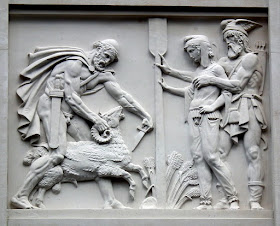 The building was designed by the Glasgow architect William Young and completed after his death in 1900 by his son Clyde. In all respects apart from the sculpture the design is standard British Imperial Baroque with giant columns and a dome at each corner. One would have expected the sculptural adornment to be either military impedimenta (displays of swords, spears, shields, flags etc), classical heroes or depictions of great British victories. What we have is a series of eight contemplative, serious, quiet allegories of war and peace that were extremely unfashionable at the time.
The building was designed by the Glasgow architect William Young and completed after his death in 1900 by his son Clyde. In all respects apart from the sculpture the design is standard British Imperial Baroque with giant columns and a dome at each corner. One would have expected the sculptural adornment to be either military impedimenta (displays of swords, spears, shields, flags etc), classical heroes or depictions of great British victories. What we have is a series of eight contemplative, serious, quiet allegories of war and peace that were extremely unfashionable at the time.In Horrors of War, a woman looks aghast at a skull. Her left hand rests on a poniard, point down in the ground. Her cloak billows around her, giving a movement that accentuates the horrific atmosphere.
Next to her sits Dignity of War, a woman wearing a helmet and armed with sword and shield. She is not triumphant and there is no hint of glorification of war: she sits quiet and pensive. The other figures in the series (for subsequent posts) are equally ambiguous.
What was the public reaction to these images at the time? There seems to have been none. Quite possibly nobody noticed them, perched as they are just under the skyline of this tall building. Nobody notices them now.















